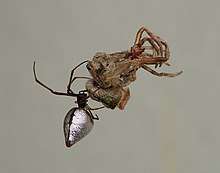Argyrodes antipodianus
Argyrodes antipodianus, also known as the dew drop spider, is a species of kleptoparasitic spider from the cobweb spider family found in Australia, New Zealand and New Caledonia.
| Dew drop spider | |
|---|---|
 | |
| Scientific classification | |
| Kingdom: | Animalia |
| Phylum: | Arthropoda |
| Subphylum: | Chelicerata |
| Class: | Arachnida |
| Order: | Araneae |
| Infraorder: | Araneomorphae |
| Family: | Theridiidae |
| Genus: | Argyrodes |
| Species: | A. antipodianus |
| Binomial name | |
| Argyrodes antipodianus O. P-Cambridge, 1880 | |
| Synonyms | |
|
Argyrodes antipodiana O.P-Cambridge,1880 | |
Taxonomy
Argyrodes antipodianus was first described in 1880 by Octavius Pickard-Cambridge as A. antipodiana from samples collected from Sydney and New Zealand by Frederick Hutton.[1] A. antipodianus was independently described again in 1885 as Argyrodes conus by Arthur Urquhart.[2] In 1917, Raymond de Dalmas provided an updated description of A. antipodiana, changed its name to A. antipodianus (although it is unclear why) and recognized A. conus as a synonym of A. antipodianus.[3] A. antipodianus was provided updated descriptions in 1924 and 1999.[4][5]
Description
Argyrodes antipodianus are generally between 2-3mm in length, with some variation between sexes and individuals. The carapace and legs are a dark brown colour whereas the abdomen is a striking bright silver colour (hence the "dew drop spider" common name) and has a conical shape.[5]
Distribution and habitat
Argyrodes antipodianus is known to occur in Eastern Australia, New Caledonia and most of New Zealand.[5] These spiders do not occur in the southern half of the South Island of New Zealand. It has been proposed that this absence is due to their preference for warmer habitats.[6]
Behaviour
Argyrodes antipodianus live on the webs of orbweaver spiders, with whom they have a kleptoparasitic relationship.[6] Whilst living on the webs of the orbweaver spiders, A. antipodianus steals smaller prey items from the larger spiders, often to their detriment. One such spider that A. antipodianus co-occurs with is Nephila plumipes. A study found that the kleptoparasitic relationship between these two species resulted in N. plumipes gaining weight at a slower rate and relocating its web more frequently than individuals of the same species who were not being hindered by these spiders.[7]
The host spider may kill A. antipodianus if it is detected. To avoid this, A. antipodianus builds a "support web" which allows the spider to move without the host detecting its presence. Using support webs, the spider can move around almost freely and will steal food bundles and may even feed on prey the same time the host is feeding on it.[8]
Known hosts
Some known hosts of A. antipodianus includes:[9][6]
- Araneus dimidiatus
- Araneus eburnus
- Argiope
- Cyrtophora
- Cyrtophora hirta
- Cyrtophora moluccensis
- Eriophora transmarina
- Eriophora pustulosa
- Gasteracantha
- Leucauge
- Nephila plumipes
- Nephila pilipes
- Nephilengys
References
- Cambridge, Rev. O. P. (2009-08-21). "3. On some new and little-known Spiders of the Genus Argyrodes, Sim". Proceedings of the Zoological Society of London. 48 (2): 320–344. doi:10.1111/j.1469-7998.1880.tb06563.x.
- Urquhart, A. T. (1885). On the spiders of New Zealand. Transactions of the New Zealand Institute 17: 31-53.
- Dalmas, R. de (1917a). Araignées de Nouvelle-Zélande. Annales de la Société Entomologique de France 86: 317-430.
- Berland, L. (1924a). Araignées de la Nouvelle Calédonie et des iles Loyalty. In: Sarasin, F. & J. Roux (eds.) Nova Caledonia. Zoologie 3, 159-255.
- Grostal, P. (1999). Five species of kleptobiotic Argyrodes Simon (Theridiidae: Araneae) from eastern Australia: descriptions and ecology with special reference to southeastern Queensland. Memoirs of the Queensland Museum 43: 621-638.
- Forster, Ray; Forster, Lyn (1999). Spiders Of New Zealand And Their World Wide Kin. Otago, New Zealand: University of Otago Press. pp. 182-183. ISBN 1 877372 13 7.
- Grostal, Paul; Walter, David Evans (1997-08-08). "Kleptoparasites or commensals? Effects of Argyrodes antipodianus (Araneae: Theridiidae) on Nephila plumipes (Araneae: Tetragnathidae)". Oecologia. 111 (4): 570–574. doi:10.1007/s004420050273. ISSN 0029-8549. PMID 28308120.
- Whitehouse, Mary E. A. (1986-04-01). "The foraging behaviours of Argyrodes antipodiana (Theridiidae), a kleptoparasitic spider from New Zealand". New Zealand Journal of Zoology. 13 (2): 151–168. doi:10.1080/03014223.1986.10422658. ISSN 0301-4223.
- Grostal, P. and Walter, D. E. (1999). Host specificity and distribution of the kleptobiotic spider Argyrodes antipodianus (Araneae, theridiidae) on orb webs in Queensland, Australia. The Journal of Arachnology 27 522-530.